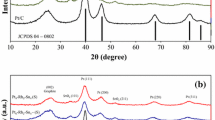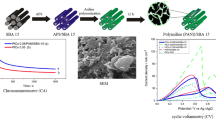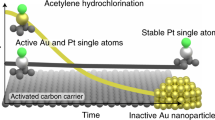Abstract
Catalyst development is needed to enable the use of renewable electricity to chemically convert carbon dioxide (CO2) and water into fuels and chemicals, a more sustainable, lower-carbon alternative to conventional processes that produce fuels and chemicals based on fossil resources. In this study, the catalytic activity and selectivity of polycrystalline platinum (Pt) is thoroughly characterized for the CO2 reduction reaction, based on an electrochemical cell design that offers high sensitivity for product detection. Thin polyaniline films are then electrodeposited onto polycrystalline Pt foils to form hybrid organic–inorganic surfaces. The addition of the polymer is observed to have an impact on the catalytic chemistry, yielding up to a fivefold enhancement in formate and CO production over pure Pt foils. This work elucidates new strategies to perturb interfacial chemistry in a manner that could help steer CO2 electro-reduction catalysis in desired directions.








Similar content being viewed by others
References
B. Dunn, H. Kamath, and J.M. Tarascon: Electrical energy storage for the grid: a battery of choices. Science 334, 928 (2011).
N.S. Lewis: Toward cost-effective solar energy use. Science 315, 798 (2007).
M. Aresta: Carbon Dioxide as a Chemical Feedstock (Weinheim, Wiley- VCH, John Wiley & Sons, 2010).
D.T. Whipple and P.J.A. Kenis: Prospects of CO2 Utilization via direct heterogeneous electrochemical reduction. J. Phys. Chem. Lett. 1, 3451 (2010).
M. Jitaru, D.A. Lowy, M. Toma, B.C. Toma, and L. Oniciu: Electrochemical reduction of carbon dioxide on flat metallic cathodes. J. Appl. Electrochem. 27, 875 (1997).
Y. Hori, H. Wakebe, T. Tsukamoto, and O. Koga: Electrocatalytic process of CO selectivity in electrochemical reduction of CO2 at metal electrodes in aqueous media. Electrochim. Acta 39, 1833 (1994).
K.P. Kuhl, E.R. Cave, D.N. Abram, and T.F. Jaramillo: New insights into the electrochemical reduction of carbon dioxide on metallic copper surfaces. Energy Environ. Sci. 5, 7050 (2012).
D.R. Kauffman, D. Alfonso, C. Matranga, H. Qian, and R. Jin: Experimental and computational investigation of Au25 clusters and CO2: a unique interaction and enhanced electrocatalytic activity. J. Am. Chem. Soc. 134, 10237 (2012).
Y. Chen, C.W. Li, and M.W. Kanan: Aqueous CO2 reduction at very low overpotential on oxide-derived au nanoparticles. J. Am. Chem. Soc. 134, 19969 (2012).
M. Watanabe, M. Shibata, A. Katoh, T. Sakata, and M. Azuma: Design of alloy electrocatalysts for CO2 reduction: improved energy efficiency, selectivity, and reaction rate for the CO2 electroreduction on Cu alloy electrodes. J. Electroanal. Chem. Interfacial Electrohem. 305, 319 (1991).
B.A. Rosen, A. Salehi-Khojin, M.R. Thorson, W. Zhu, D.T. Whipple, P.J.A. Kenis, and R.I. Masel: Ionic liquid-mediated selective conversion of CO2 to CO at low overpotentials. Science 334, 643 (2011).
K. Ogura, N. Endo, and M. Nakayama: Mechanistic studies of CO2 reduction on a mediated electrode with conducting polymer and inorganic conductor films. J. Electrochem. Soc. 145, 3801 (1998).
B. Aurian-Blajeni, I. Taniguchi, and J.O.M. Bockris: Photoelectrochemical reduction of carbon dioxide using polyaniline-coated silicon. J. Electroanal. Chem. 149, 291 (1983).
R. Aydin and F. Koleli: Electrochemical reduction of CO2 on a polyaniline electrode under ambient conditions and at high pressure in methanol. J. Electroanal. Chem. 535, 107 (2002).
A. Zhang, W. Zhang, J. Lu, G.G. Wallace, and J. Chen: Electrocatalytic reduction of carbon dioxide by cobalt-phthalocyanine-incorporated polypyrrole. Electrochem. Solid-State Lett. 12, E17 (2009).
G.T. Rochelle: Amine scrubbing for CO2 capture. Science 325, 1652 (2009).
A.A. Peterson and J.K. Nørskov: Activity descriptors for CO2 electroreduction to methane on transition-metal catalysts. J. Phys. Chem. Lett. 3, 251 (2012).
G.M. Brisard, A.P.M. Camargo, F.C. Nart, and T. Iwasita: On-line mass spectrometry investigation of the reduction of carbon dioxide in acidic media on polycrystalline Pt. Electrochem. Commun. 3, 603 (2001).
K.P. Kuhl, T. Hatsukade, E.R. Cave, D.N. Abram, J. Kibsgaard, and T.F. Jaramillo: Electrocatalytic conversion of carbon dioxide to methane and methanol on transition metal surfaces. J. Am. Chem. Soc. 136, 14107–14113 (2014).
C.M.G.S. Cruz and E.A. Ticianelli: Electrochemical and ellipsometric studies of polyaniline films grown under cycling conditions. J. Electroanal. Chem. 428, 185 (1997).
Z. Chen, T.F. Jaramillo, T.G. Deutsch, A. Kleiman-Shwarsctein, A.J. Forman, N. Gaillard, R. Garland, K. Takanabe, C. Heske, M. Sunkara, E.W. McFarland, K. Domen, E.L. Miller, J.A. Turner, and H.N. Dinh: Accelerating materials development for photoelectrochemical hydrogen production: standards for methods, definitions, and reporting protocols. J. Mater. Res. 25, 3 (2011).
E.P.M. Leiva, E. Santos, and T. Iwasita: The effect of adsorbed carbon monoxide on hydrogen adsorption and hydrogen evolution on platinum. J. Electroanal. Chem. Interfacial Chem. 215, 357 (1986).
C.Q. Cui, X.H. Su, and J.Y. Lee: Measurement and evaluation of polyaniline degradation. Polym. Degrad. Stab. 41, 69 (1993).
K.J. Schouten: Electrocatalytic Carbon Dioxide Reduction, a Mechanistic Study, in Chemistry (Leiden University, Leiden Institute of Chemistry, Netherlands, 2013).
S. Zhang, P. Kang, and T.J. Meyer: Nanostructured tin catalysts for selective electrochemical reduction of carbon dioxide to formate. J. Am. Chem. Soc. 136, 1734 (2014).
A.G. MacDiarmid, J.C. Chiang, and A.F. Richter: Polyaniline–a new concept in conducting polymers. Synth. Met. 18, 285 (1987).
A.J. Morris, R.T. McGibbon, and A.B. Bocarsly: Electrocatalytic carbon dioxide activation: the rate-determining step of pyridinium-catalyzed CO2 reduction. ChemSusChem 4, 191 (2011).
E.B. Cole, P.S. Lakkaraju, D.M. Rampulla, A.J. Morris, E. Abelev, and A.B. Bocarsly: Using a one-electron shuttle for the multielectron reduction of CO2 to methanol–kinetic, mechanistic, and structural insights. J. Am. Chem. Soc. 132, 11539 (2010).
K.D. Vogiatzis, A. Mavrandonakis, W. Klopper, and G.E. Froudakis: Ab initio study of the interactions between CO2 and N-containing organic heterocycles. Chemphyschem: Eur. J. Chem. Phys. Phys. Chem. 10, 374 (2009).
Acknowledgments
The authors acknowledge support from the Global Climate Energy Project at Stanford University as well as the US Department of Energy, Office of Science, Office of Basic Energy Sciences, under Contract No. DE-SC0008685. D. N. A. acknowledges fellowship support from Chevron through the Stanford Graduate Fellowship (SGF) Program. E. R. C. and K. P. K. acknowledge fellowship support from the National Science Foundation Graduate Research Fellowship Program (NSF GRFP). The authors also acknowledge Ms. Michelle Vezie for technical assistance on this project.
Author information
Authors and Affiliations
Corresponding author
Supporting Information for
Supplementary materials
Supplementary materials
For supplementary material for this article, please visit http://dx.doi.org/10.1557/mrc.2015.30
Rights and permissions
About this article
Cite this article
Abram, D.N., Kuhl, K.P., Cave, E.R. et al. Platinum and hybrid polyaniline–platinum surfaces for the electrocatalytic reduction of CO2. MRS Communications 5, 319–325 (2015). https://doi.org/10.1557/mrc.2015.30
Received:
Accepted:
Published:
Issue Date:
DOI: https://doi.org/10.1557/mrc.2015.30




